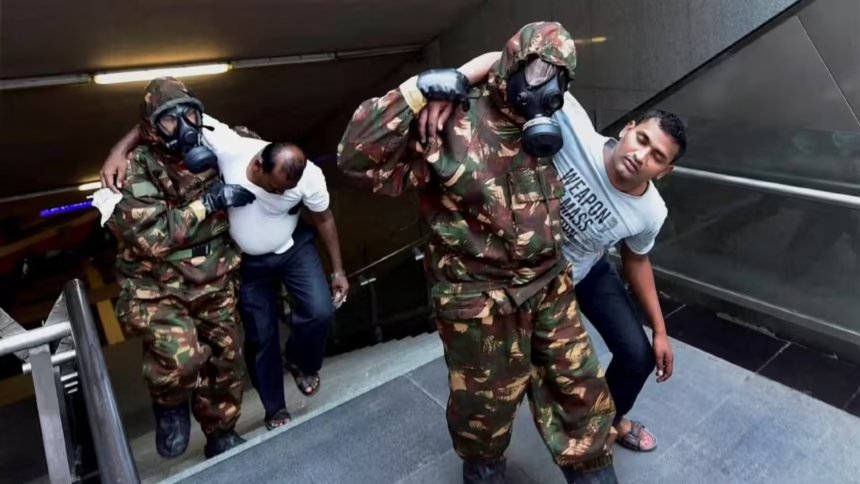
In the wake of the Pahalgam terror attack that claimed 26 lives in Jammu and Kashmir, the Union Ministry of Home Affairs (MHA) has directed all states and Union Territories to conduct nationwide mock drills on May 7. The drills are aimed at enhancing civil defence preparedness amid emerging threats from the evolving geo-political landscape.
Background: Tensions After Pahalgam Terror Attack
The drills come shortly after high-level meetings chaired by Prime Minister Narendra Modi to discuss India’s response to the April 22 Pahalgam terror attack. On the same day, Pakistan conducted its second missile firing test in 48 hours under “Exercise INDUS”, heightening border tensions. Pakistan’s Prime Minister Shehbaz Sharif said the tests signaled that “Pakistan’s defence is in strong hands.”
MHA’s Mock Drill Objectives
According to a directive from the Directorate General Fire Service, Civil Defence and Home Guards, the mock drill seeks to assess India’s resilience in case of a hostile attack. The core objectives include:
- Testing air raid warning systems
- Operationalising hotline/radio communication with the Indian Air Force
- Verifying control room and shadow control room functionality
- Training civilians, students, and volunteers on civil defence measures
- Executing crash blackout protocols for vital installations
- Implementing camouflaging procedures for strategic locations
- Evaluating emergency response from wardens, firefighters, rescue teams
- Simulating evacuation drills up to the village level
Participants in the May 7 Drill
The nationwide drill will involve a wide array of stakeholders, including:
- District Controllers and local authorities
- Civil Defence Wardens and volunteers
- Home Guards (active and reserve)
- National Cadet Corps (NCC), National Service Scheme (NSS)
- Nehru Yuva Kendra Sangathan (NYKS)
- College and school students
The MHA mock drills on May 7 are designed to enhance coordination among defence services, civic bodies, and citizens, ensuring swift responses in the event of aggression or disaster.
What will happen during mock drill on May 7?
On May 7, the drills will be carried out across officially notified Civil Defence districts in coordination with state and district authorities. Participants will include Civil Defence wardens, Home Guards, National Cadet Corps (NCC), National Service Scheme (NSS) volunteers, Nehru Yuva Kendra Sangathan (NYKS) members, and students from schools and colleges.
Citizens may experience short-term power cuts, blackout simulations, loud sirens,and restricted access to certain public areas. Traffic may also be diverted temporarily in some cities. These are part of a controlled exercise and not actual threats.
Crash Blackouts
Cities may switch off visible lights to mimic blackout conditions used during wars. This reduces the risk of detection during night-time airstrikes. India last used this method extensively in 1971.
Camouflage Exercises
Critical installations — including communication towers, power plants, and military areas — will undergo camouflage operations to test concealment techniques from aerial or satellite monitoring.
Early blackout drills already underway
Some areas have already begun similar exercises. On Sunday evening, Ferozepur Cantonment in Punjab held a 30-minute blackout drill. Located near the India-Pakistan border, the area is among those on high alert. The drill served as a preview of the upcoming nationwide exercise.
Policy roots and long-term planning
This move is aligned with the Centre’s long-term strategy to boost civil preparedness. The renewed push began at the ‘Chintan Shivir’ in October 2022, where top leaders stressed the need for nationwide readiness. A follow-up letter from the Union Home Secretary in January 2023 called for strengthening civil defence, particularly in border and coastal regions.
India’s civil defence drill on May 7 is a planned measure aimed at improving national readiness. While the context is serious, the intention is precautionary. Public cooperation and awareness are key to making such drills effective and meaningful.
Geo-Political Urgency
With India suspending visa services to Pakistan, putting the Indus Waters Treaty in abeyance, and closing its airspace to Pakistani flights, the situation remains volatile. These drills serve as a proactive civil defence measure in preparation for any scenario.
Also read: UNSC Reacts to Pahalgam Terror Attack: Diplomats Urge India-Pakistan Dialogue


